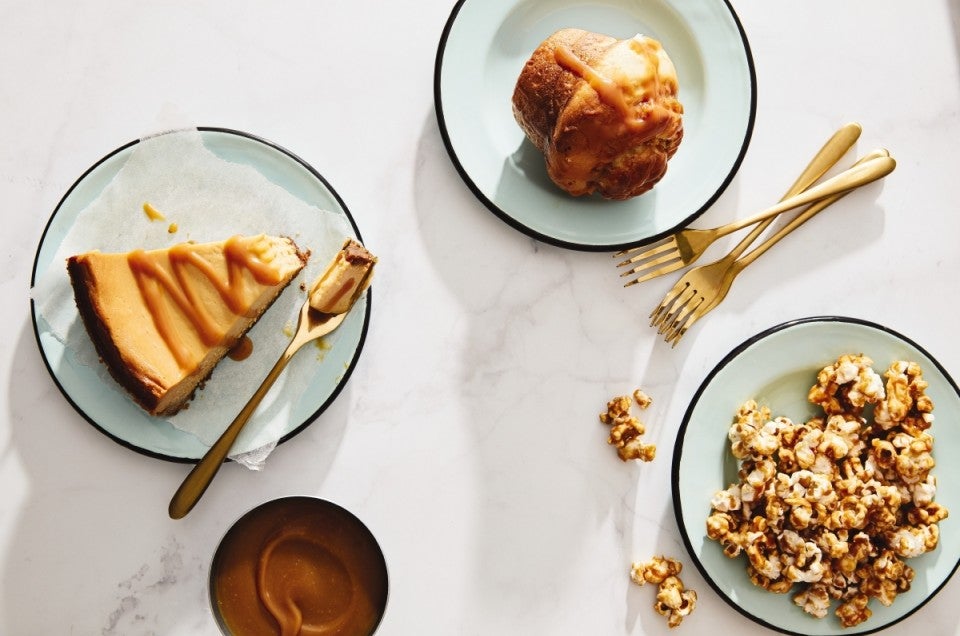



Sift magazine is here for the holidays. Each page bursts with festive and colorful inspiration for the season. For us, that's cause for celebration. Pick up a copy here. Today, we're taking a quick tour through one of its stories as we give you some ideas for the very best ways to bake with caramel.
The alchemy of heat and sugar is the source of many baking wonders. We count on it for golden brown cake layers, crisp cookie edges, and the miraculous sauce that pools over sticky toffee pudding. In its purest form, sugar plus heat equals caramel, and it’s a formula we’re endlessly happy to put to use in myriad recipes. We've collected a few stand-outs to share today.

Caramel is compelling and wonderful in its own right, a complex mix of toasted, buttery, bitter, and sweet flavors all at once. It has an undeniable allure in baking, enhancing everything from vanilla, salt, and fruit to chocolate, nuts, dairy, and even beer.
Smooth and silky, caramel sauce is surprisingly easy to make.
Once you master the technique, you can create many shades of amber between toasted sugar and deep, rich caramel. (To take a closer look at the step-by-step process to making basic caramel, read PJ's excellent guide here.)
Before you start baking, let's talk about exactly how caramel comes to be.
The transformative power of heat is at its most dramatic (and delicious) when applied to sugar. First, sugar melts, going from solid to liquid. As it continues to cook, it begins to change color and caramelize. The cascade of molecular changes that ensues creates hundreds of distinct flavors including butterscotch, toasted nuts, and sweet rum. As cooking continues, the cooked sugar becomes less sweet, and bitter notes can creep in. Caramelization is its own distinct process, similar to but not the same as the Maillard reaction.
When cooked in the presence of other ingredients (like dairy or corn syrup) sugar will both caramelize and go through the Maillard reaction, where amino acids and melted sugars undergo their own flavor-producing transformations, creating hundreds of distinct flavor compounds that we seek out every day. Roasted coffee, crisp brown toast, caramel sauce, roasted vegetables, and meat all owe their appeal to the Maillard reaction.
The recipes we'll talk about today all feature caramel in different forms, but if you want to start simple, we've got you covered. You can make your own Caramel Sauce, which is delicious over ice cream or drizzled atop pound cake.

Or whip up a batch of classic caramel candies. These are especially good when topped with a bit of flaky sea salt.

Close attention and a sense for the opportune moment to add butter and cream (which stops the caramelization process) will be rewarded with the freshest, most luscious caramel sauce, ready for drizzling over ice cream or putting to use in our recipes for Butter Pecan Kringle, Caramel Apple Biscuits, or Caramel-Apple Cinnamon Buns.

For a more sophisticated approach, try a Caramel Pecan Cheesecake, which balances the sweetness of caramel with tangy cream cheese and nutty pecans. It’s a decadent combination, one that we reach for on special occasions.

Or cook it a little longer and take caramel into candy territory — one of our favorite homemade gifts. Start with Dark Chocolate Buttercrunch: a simple recipe that makes a big impression; it has hundreds of rave reviews from King Arthur customers. Crisp and salty-sweet, our Caramel Corn is another easy-to-make option, that makes an excellent thank you present during the holidays. (Follow along in our blog article here for a visual step-by-step of the popcorn recipe.)

Simple but complex, smooth and pourable, or cooked to crunchy candy form, caramel’s allure is powerful and timeless. Measure some sugar, turn up the heat, and watch the magic happen.
Inspired? Ready for sugar? Start with one of the recipes we've talked about here, or tell us your favorite way to bake with caramel in the comments!

